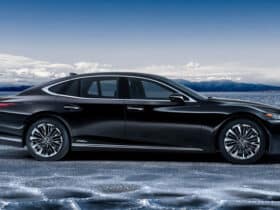In a world where technology is pushing boundaries like never before, one innovation stands out as a harbinger of change: autonomous driving. At the forefront of this revolution is Tesla, a company that has redefined the automotive landscape by boldly venturing into the realm of self-driving cars. As you buckle up and prepare to navigate the intricate roads of Tesla Autopilot, we delve into the heart of this groundbreaking technology, exploring its features, advantages, challenges, and the implications it holds for the future.
Understanding Tesla Autopilot
At its core, Tesla Autopilot represents a paradigm shift in transportation. It’s not just about getting from point A to B; it’s about redefining the very act of driving. Autopilot, distinct from Full Self-Driving (FSD), is an advanced driver-assistance system that equips Tesla vehicles with the ability to control steering, acceleration, and braking within certain conditions. While Full Self-Driving aims to achieve complete autonomy, Autopilot is an intermediary step, designed to enhance safety and convenience.
Key Features of Tesla Autopilot
Tesla’s Autopilot is a symphony of sophisticated features that work in harmony to make your journey safer and more comfortable. Autosteer, one of its flagship capabilities, allows your car to stay within its lane, even navigating bends effortlessly. The Traffic-Aware Cruise Control maintains a safe following distance and adapts your car’s speed to match traffic flow. And let’s not forget Autopark and Summon, features that transform parking from a chore to a leisurely task, all at the touch of a button.
Advantages of Using Tesla Autopilot
Safety takes the front seat when it comes to Tesla Autopilot. The system’s ability to process vast amounts of data in real-time ensures a keen awareness of the surroundings, significantly reducing the risk of accidents caused by human error. By automatically adjusting speed and maintaining optimal distances, Autopilot minimizes the chances of collisions. Moreover, as more cars adopt autonomous technology, traffic flow could become smoother, reducing congestion and time spent on the road.
Challenges and Limitations
Despite its promises, Tesla Autopilot is not without its challenges. The technology, while impressive, is not foolproof, and drivers must remain vigilant and ready to take control at any moment. Accidents involving Tesla vehicles in Autopilot mode have raised concerns about its safety. Moreover, the ethical and legal complexities of autonomous driving have cast a shadow over the industry. As we hurtle toward a future where cars make life-or-death decisions, we’re left grappling with the weight of programming morality into machines.
Tesla’s Approach to Safety
Tesla doesn’t cut corners when it comes to safety. Redundancy is the name of the game, with multiple sensors and systems working in tandem to ensure fail-safe operations. What’s more, over-the-air updates continuously refine Autopilot’s performance, allowing your car to get smarter over time. This iterative approach not only demonstrates Tesla’s commitment to safety but also exemplifies its agile methodology in adapting to challenges.
The Road to Full Self-Driving
Tesla’s journey toward Full Self-Driving is a multi-phase process. The company’s iterative approach means that new features and capabilities are continually being added. However, regulatory roadblocks remain a substantial hurdle. Collaborating with authorities to establish guidelines and safety standards for self-driving cars is essential for realizing the dream of autonomous transportation.
Public Perception and User Experiences
Real-world users have taken Autopilot for a spin, sharing both awe-inspiring and cautionary tales. Trusting a machine with your life can evoke a wide range of emotions. Some users report moments of astonishment as their cars navigate complex scenarios flawlessly, while others approach the technology with skepticism. Balancing these perceptions is vital as autonomous vehicles become an increasingly common sight on our roads.
Competition and Industry Trends
Tesla is not alone in the race toward autonomy. Traditional automakers and tech giants alike are investing heavily in self-driving technology. However, Tesla’s unique approach of deploying partially autonomous features through over-the-air updates gives it a distinctive edge. The fusion of artificial intelligence and machine learning is shaping not only Tesla’s vehicles but also the entire automotive landscape.
The Future Landscape of Autonomous Driving
Imagine a city where traffic flows seamlessly, accidents are rare, and the commute is a stress-free experience. This is the vision that autonomous driving promises to bring to life. As self-driving cars become more integrated into urban planning, questions arise about how our cities might evolve. From redesigned streets to optimized energy consumption, the possibilities are boundless.
Ethical Considerations and Decision-Making
Autonomous cars will be faced with dilemmas that were once reserved for philosophical debates. The classic trolley problem takes on new meaning when encoded in lines of code. Should a car prioritize the safety of its occupants, or should it make decisions that minimize overall harm, even if it means putting its passengers in danger? Striking the right balance between utilitarianism and individual safety is a moral tightrope automakers must navigate.
Lexus Advanced Safety Technology: Ensuring a Safer Driving Experience
The Role of Regulations and Legislation
The pace of technological advancement often outstrips the pace of legislation. As autonomous vehicles edge closer to reality, governments around the world are grappling with creating regulatory frameworks that balance innovation with safety. Establishing cohesive global standards is no small feat, but it’s a necessary step in ensuring a smooth transition to a world of self-driving cars.
Tesla’s Autopilot in Popular Culture
Autopilot isn’t just confined to the realm of engineering and innovation; it’s making its mark on popular culture too. References to autonomous driving and self-parking cars are becoming increasingly common in movies, TV shows, and even literature. These portrayals shape how the general public perceives autonomous technology and play a part in normalizing its presence in our lives.
The Intersection of Autonomy and Sustainability
The benefits of autonomous driving extend beyond convenience and safety. By optimizing routes and driving patterns, self-driving cars can contribute to a significant reduction in carbon emissions and fuel consumption. When combined with the electric vehicle revolution, autonomous technology has the potential to revolutionize the way we move while also minimizing our environmental footprint.
Conclusion
As the road stretches ahead, Tesla Autopilot is at the helm of redefining mobility. Its evolution from a mere concept to a transformative reality has been marked by challenges and breakthroughs alike. While questions and uncertainties linger, there’s no denying that the future is steering toward a world where the act of driving is transformed, and the possibilities are as limitless as the open road.
Frequently Asked Questions
1. Is Tesla Autopilot completely self-driving?
Tesla Autopilot is not fully self-driving but rather an advanced driver-assistance system. It can control steering, acceleration, and braking in certain conditions, but drivers must remain attentive and ready to take control.
2. How safe is Tesla Autopilot?
Tesla takes safety seriously and incorporates redundant sensors and fail-safes in its vehicles. However, accidents have occurred, highlighting the need for drivers to be vigilant and engaged while using Autopilot.
3. What’s the difference between Autopilot and Full Self-Driving?
Autopilot offers advanced driver-assistance features, while Full Self-Driving aims for complete autonomy. Full Self-Driving includes additional capabilities like automatic lane changes and navigating on city streets.
4. Can I use Tesla Autopilot anywhere?
Tesla Autopilot is designed for specific scenarios, such as highway driving. It’s important to follow Tesla’s guidance on where and when Autopilot can be used safely.
5. How does Tesla gather data to improve Autopilot?
Tesla vehicles collect data from sensors and cameras during Autopilot use. This data is anonymized and sent back to Tesla to improve the system’s performance through over-the-air updates.








